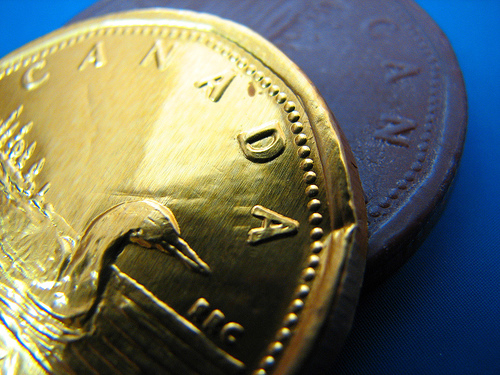There’s a refreshingly pragmatic and detailed piece in the National Post by Peter Spiro questioning the assumed correlation between oil prices and the loonie. It builds nicely on previous discussion of the “oil price-loonie transmission mechanism” that has occurred here and here.
Among other salient points, Mr. Spiro points out that:
– Canadian petroleum exports have grown, but not that dramatically (especially as a share of GDP).
– Despite strong energy exports, Canada has a large trade deficit which should (other things being equal) depress the currency.
– FDI flows have been leaving Canada on a net basis, not coming in.
– The loonie is clearly overvalued (by 25 per cent according to OECD estimates).
– Portfolio inflows (especially into Canadian bonds) have been a key mechanism for lifting the currency, and those inflows are motivated in large part by the expectation of traders that the loonie will rise (thus enhancing the return for foreign purchasers of those bonds).
– Financial markets show herd-like behaviour, following fads that often turn out to be irrational.
– The market’s assumption that high oil prices inevitably produces a high dollar could be another such fad.
– The Bank of Canada may have inadvertently promoted that herd-like thinking with its past research (dating back to 2006) about the determinants of the dollar. [I don’t know if I fully buy this argument … traders obviously look at the Bank’s models, but I don’t think they are that sheep-like … and more recently, the Bank has actually been trying to break the univariate association in traders’ minds between oil prices and the dollar.]
– Whatever its causes, the Bank of Canada could disrupt this self-fulfilling consensus among traders by leaning against the bubble in the currency more forcefully — thus forcing traders to change their underlying model of what determines the dollar. [I think this argument is strong.]
A smart financial trader is not one who actually knows the true value of a loonie. It is, rather, someone who can accurately predict how others in the market will respond to new information bout the loonie. The dollar rising with the oil price is therefore merely a confirmation that most financial traders think the same way — not a confirmation that Canada’s true “fundamentals” have been enhanced by higher oil prices. We’ve seen what this kind of herd thinking can produce in the past, and Spiro warns it could happen here too.
The whole scenario reminds me of the judges in Keynes’s beauty contest (General Theory, Chapter 12):
“It is not a case of choosing those [faces] that, to the best of one’s judgment, are really the prettiest, nor even those that average opinion genuinely thinks the prettiest. We have reached the third degree where we devote our intelligences to anticipating what average opinion expects the average opinion to be. And there are some, I believe, who practice the fourth, fifth and higher degrees.”
Financial markets don’t judge the truth; they play on fleeting judgments about what others think is the truth. In that regard, the link between oil prices and the loonie (which is strong in recent empirical experience) is nothing more than a self-fulfilling assumption by those who actually make this market.
Speaking of tilting against the windmills of market consensus, here are a couple of additional tidbits relevant to the debate over the loonie and what should be done about it: the Globe and Mail’s Kevin Carmichael drew to my attention some recent IMF work that provides both theoretical and political support for economies to sterilize capital inflows with the deliberate goal of offsetting overappreciation. This recommendation is aimed explicitly at successful emerging economies with strong currencies (like Brazil), but there’s no inherent reason why the same logic wouldn’t apply to Canada. Sterilizing or discouraging the big portfolio inflows that Spiro discusses might be a promising avenue.
And Daniel Poon at the North-South Institute has referred me to recent work by Kevin Gallagher making a case for more direct interventions to manage exchange rates and portfolio flows.
Jim Stanford is an economist with the CAW. This article was first posted on the Progressive Economics Forum.
Photo: merlinprincesse/Flickr




